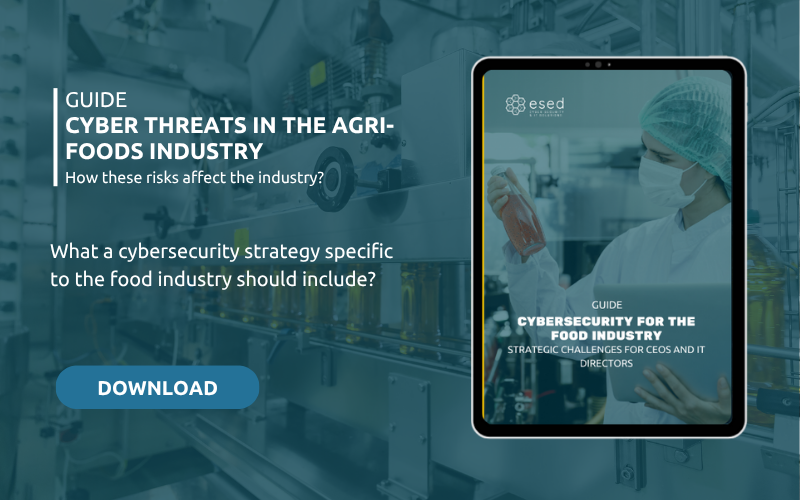Cybersecurity trends for the food industry 2026
By Eduard Bardají on Oct 9, 2025 9:10:02 AM

The food industry is undergoing a remarkable digital transformation. Production plants are becoming increasingly smart and connected, extending traceability and automation systems across the entire supply chain. This technological evolution has optimized efficiency but has also elevated cybersecurity from a technical requirement to a key strategic factor for safeguarding business continuity.
Today, a cyberattack is no longer just about data theft; its aim can be direct interference with industrial processes, manipulation of sensors and SCADA/PLC systems, or attacks on critical suppliers within the chain. The complexity of these environments, which include industrial IoT technology and hybrid work settings, demands protection that is continuous, scalable, and intelligent.
Cybersecurity trends for the food industry 2026
Security by design
Security is not an afterthought. In 2026, the trend is to integrate security controls directly from the design phase of every software, sensor, or automation system. This includes network segmentation and rigorous vendor validation. This approach is essential because it reduces operational risks and prevents unplanned disruptions from the outset, optimizing costs.
IT/OT environment segmentation and protection
Strict separation of corporate networks (IT) from industrial systems (OT) remains critical to protecting production and food traceability. The 2026 trend strengthens this division using industrial firewalls, segmented VLANs, and strict role-based access control. Proper segmentation prevents common attacks, such as those initiated via email, from spreading to plant control systems, ensuring continuity.
Continuous monitoring and automated response
Security solutions are no longer just for alerting, they must act. The trend points to adopting MDR (Managed Detection & Response) systems and AI-based tools for real-time network and device monitoring. These systems are critical because they can automatically isolate threats and contain incidents as soon as abnormal behavior is detected, drastically reducing mean time to detect and respond.
Strict identity and access management
In complex environments involving internal operators, external technicians, and suppliers, access control is non-negotiable. 2026 strategies extend the use of MFA (Multi-Factor Authentication), the principle of least privilege, and periodic audits to OT environments. This ensures that every user or system only receives the minimum access necessary, limiting the consequences of human error or credential misuse.
Intelligent patch and connected asset management
Industrial equipment and connected sensors pose risks if not regularly updated. The trend focuses on implementing advanced policies that automate software and firmware updates without disrupting production. This is complemented by real-time asset inventories and prioritization of truly critical vulnerabilities, strengthening overall plant resilience.
Cyber resilience drills and continuous training
Cyber resilience is a skill that must be practiced and improved. Companies are increasingly conducting ransomware drills, penetration tests, and coordinated response exercises among IT, OT, and production teams. These practical exercises are essential to assess reaction times and reinforce internal protocols, while continuous hands-on training strengthens a security-conscious culture at all organizational levels.
Supplier and digital supply chain security
Dependence on third parties, for software, logistics, or certification services, increases the attack surface. The 2026 security trend enforces "Zero Trust" policies for suppliers, meaning active monitoring of external access and continuous evaluation of partners’ security posture. This preventive strategy is vital to prevent a security breach in a third party from disrupting the production chain.
Protection of critical data with advanced techniques
Critical food industry data, traceability records, formulas, and laboratory results, are strategic assets that must be safeguarded. The protection trend focuses on implementing advanced encryption, data anonymization, and automated integrity audits. This ensures that the most sensitive information remains secure, even in collaborative environments or multi-cloud architectures.
Cyber intelligence and emerging threat detection
Threats are constantly evolving. Applied cyber intelligence allows organizations to identify attack patterns at the industry level before they affect the company. This anticipatory capability includes detecting risks such as deepfakes in certifications, malware targeting PLCs or industrial sensors, and sector-specific phishing campaigns. Early insights turn information into a strategic advantage.
Digitalization has optimized the efficiency of the agri-food supply chain, but it has also drastically expanded the attack surface.
In 2026, integrating technology, processes, and an active security culture will be key to maintaining production, protecting food quality, and ensuring the trust of consumers and distributors.
Cybersecurity is no longer just a technical requirement, it has become a driver of resilience, efficiency, and competitiveness.
At ESED, we help food companies anticipate risks, strengthen their cyber resilience, and comply with today’s standards, tailoring each strategy to their technological and operational realities.
You May Also Like
These Related Stories

Cybersecurity trends for Biotechs 2026

What is social engineering and how to protect yourself: Complete Guide




.png?width=262&height=150&name=accio-10-negre%20(1).png)

